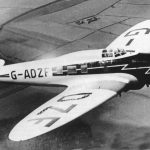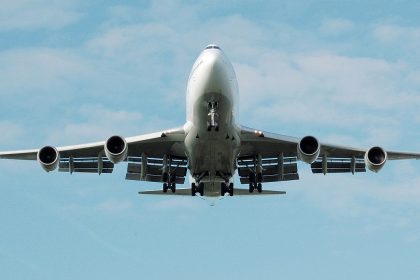

The X-4 was a research aircraft developed by the Northrop Corporation to test the stability of semi-tailless wing designs at transonic speeds in excess of Mach 0.9. Already there had been tailless aircraft similar to the X-4 in the form of the Messerschmitt Me 163 Komet rocket-powered interceptor and the De Havilland DH.108 Swallow research aircraft, and the company’s funder Jack Northrop was an advocate of the flying wing design, as evident in the N1M, N9M, XB-35, and YB-49 designs. This experience secured Northrop a contract for two experimental aircraft to be built at the Northrop factory in Hawthorne, CA before they were accepted into the US Air Force as serial number 46-676 and 46-677.
The X-4 was among the smallest manned experimental aircraft built, with a length of 23 ft 3 in, a wingspan of 26 ft 10 in, and a height of 14 ft 10 in. It weighed 7,820 lbs. on takeoff and was powered by two Westinghouse J30-WE-7 axial-flow turbojet engines. For better maintenance access, the small tail of the aircraft could be removed to work on or remove the engines. The X-4 had no horizontal stabilizer in order to avoid interaction of shockwaves between the wings but had a vertical stabilizer and rudder. Control of the X-4’s pitch and roll axes was done through the use of elevons, which combine the function of ailerons and elevators, a device the Northrop had used extensively in its flying wing designs that had also been tested at Muroc.

The first X-4 Bantam, 46-676, was brought to Muroc in November 1948 to begin subsequent taxi tests before making its first flight on December 15 with Northrop test pilot Charles Tucker at the controls. But while other flights were rescheduled, Rogers Dry Lake was flooded by winter rains, and further flight tests were put on hold until April 1949. When flight testing resumed, 46-676 was revealed to be mechanically unreliable and possessed poor flight characteristics, with Walter C. Williams, head of the National Advisory Committee for Aeronautics (NACA) Muroc Flight Test Unit (now NASA’s Armstrong Flight Research Center) calling the aircraft a “lemon.” After just 10 flights, 46-676 was permanently grounded, and with the arrival of its sister ship, 46-677, was kept as a source of spare parts to keep -677 flying.

In February 1950 Northrop handed the two X-4s to the Air Force and NACA for official flight testing. Among the Air Force test pilots to fly X-4 46-677 in the summer of 1950 were Chuck Yeager, Frank Kendall Everest, Jr., Al Boyd, Richard Johnson, Fred Ascani, Arthur Murray and Jack Ridley, and on September 28, 1950, John H. Griffith became the first NACA pilot to fly the X-4.
Initial NACA flight tests placed emphasis on the Bantam’s pitch sensitivity. At Mach 0.88, it was noted that it began oscillating violently, and that such oscillation increased with speed, becoming more and more difficult to control. As a result of this, NACA engineers decided to experiment with the thickness of the flaps that also opened up as speed brakes, which was achieved by adding balsa wood strips between the halves. Test flights by NACA pilots Walter Jones and Scott Crossfield demonstrated that the Bantam’s pitch stability had improved, and the X-4 would not oscillate until Mach 0.92. Despite further tests both with and without the balsa strips, the X-4 Bantam could never shake its tendency to oscillate at transonic speeds. With the final NACA test flight being made on September 29, 1953, the X-4 program was officially retired. The final report concluded that, at the then-current state of aeronautical engineering, tailless aircraft were not suitable for supersonic flight, and the Northrop X-4 Bantam gained a reputation as being one of the worst x-planes in aviation history.
Today, both X-4s remain in existence. 46-677 is on display in the Research and Development gallery of the National Museum of the United States Air Force at Wright-Patterson Air Force Base in Dayton, OH, while 46-676 was displayed at the United States Air Force Academy near Colorado Springs, CO, where its diminutive size saw it used in several midnight-mover pranks before it was later placed on display inside the Air Force Flight Test Museum at Edwards Air Force Base, CA, which is now preparing to move just outside Edwards’ West gate to improve public access, which is currently restricted to those with clearance to get on the base. Though it was not viewed favorably by the test pilots who flew it, the Northrop X-4 Bantam was noteworthy in that no examples of the design were at point lost during its flight-testing program, and it still taught some valuable lessons about tailless aircraft. Considering this, it has certainly secured its place in aviation history.
Today in Aviation History is a series highlighting the achievements, innovations, and milestones that have shaped the skies. All the previous anniversaries are available HERE































